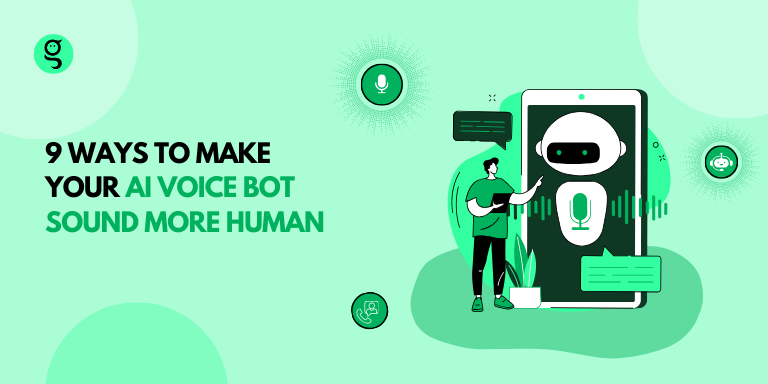Have you ever called a company and felt like you were talking to a robot? You know, one of those awkward, stilted conversations where you find yourself repeatedly saying "Hello?" to check if anyone is still on the line? We know it's not a great experience.
With AI-powered assistants becoming more and more common, making sure they sound natural is key to providing good customer service. No one wants to feel like they're talking to a cold, robotic bot. The good news is, that there are several techniques you can use to make your AI-powered voice bots interact more naturally with your customers. Stick with us, and we'll take you through some powerful methods to give your voice bot a more human touch.
Should Voice Bots Sound Human?
According to Voicebot Research, 71% of consumers prefer human voices over synthetic ones when asked about their voice experiences. So, we’re sure you won't be surprised when we say that yes, giving voice bots human-like responses does improve customer satisfaction. Because, let's be honest, we all prefer a warm, natural conversation over an awkward, stilted one.
However, it's also important that voice bots don't pretend to actually be human. Transparency about their identity as AI assistants is crucial for building trust with customers as no one likes being tricked right?
The key is finding the right balance - ai phone calling voice bots should sound casual and conversational without claiming to be something they aren't. This leads to the smoothest, most pleasant interactions for your customers.
9 Ways to Make Your AI Voice Bot Sound More Human
Alright, now that we're clear on why making voice bots sound human-like is important, let's get into the nitty-gritty techniques to pull it off:
1. Understand Context, Not Just Keywords:

Many early voice bots simply scanned for trigger words without looking at the broader context of a conversation. This led to jarring, irrelevant responses that frustrated users.
Newer improved natural language processing allows voice bots to evaluate the full conversational context in order to continue discussions smoothly instead of getting fixated on specific keywords. This makes interactions much more natural.
2. Use Conversational Fillers & Small Talk Naturally:
Human conversations include natural fillers like "um", "uh huh", and casual small talk about the weather or one’s well-being.
By programming these conversational patterns into voice bots, makes the discussion flow in an organic, laidback way - no more awkward pauses or canned topic shifts.
3. Vary Tone & Inflection:
Monotone robotic voices are a dead giveaway that you're talking to a bot. By building in the ability to alter speech speed, pitch, volume, and inflection appropriately, voice bots can convey different emotions and tones just like a real person.
Additionally, you can also create various personas having different speech speeds, pitch, volume, and inflection so that you can choose the right one based on your needs. This helps conversations feel more natural and allows bots to respond situationally based on context cues. A friendly, helpful voice puts customers at ease too.
4. Give It an Appropriate Personality:

Just like real people, the most relatable voice bots have a consistent personality. Is your bot professional and serious or casual and funny? Aligning personality with your brand image helps cement what customers can expect.
A bot that cracks the occasional joke when appropriate or provides cheerful, reassuring responses when users are frustrated builds rapport. But avoid overusing humor - that just feels awkward.
5. Implement Randomness & Variation:
If voice bots give the exact same repetitive responses every time, it becomes obvious you're not chatting with a human.
Programming some appropriate randomness and variation into replies makes conversations feel more natural. Humans don't use the exact same phrasing verbatim every time, so neither should bots.
6. Incorporate Interruption Handling & Repeat Responses:
Real people can handle being interrupted or asked to repeat themselves without getting derailed, so voice bots need this capability too.
By detecting interruptions and asking for clarification, then smoothly repeating or rephrasing statements when requested, bots show they accurately understand the conversation flow - just like a real assistant would. Advanced voice bots like VoiceGenie can handle any type of interruption and can even repeat its answers when the customer asks for it.
7. Admit Mistakes & Ignorance:

Nobody knows everything, right? So why do some voice bots pretend otherwise?
Building transparency when bots lack the necessary knowledge to address user queries makes interactions more truthful. No more guesswork or made-up answers. Admitting limitations builds trust.
8. Integrate Empathetic Response:
Here's a tricky conversation skill that sets apart good voice bots from great ones - integrating empathetic emotional responses using active listening techniques.
Using sentiment analysis to detect user emotions like frustration, disappointment, etc. allows bots to provide appropriate empathetic replies. Further showcasing understanding by summarizing issues makes customers really feel heard.
9. Continuously Expand Its Knowledge Base:

No human knows everything off the bat - knowledge comes with experience over time. Similarly, the best voice bots continuously learn from conversations to improve responses rather than stagnate after launch.
Consistently expanding the knowledge base enables bots to handle an ever-wider array of customer queries with increasing confidence.
Here’s What You Should Do Next
There you have it. Effective tips to make your AI voice bots interact more naturally with customers while still retaining transparency. Finding that delicate balance leads to awesome customer experiences too.
Want to experience our human-like voice AI? Book a personalized demo with VoiceGenie to see our voice bots in action as they engage with customers naturally while flaunting their machine identity.
See for yourself how VoiceGenie’s multilingual voice automation can benefit your business. Our AI-powered voice bots handle customer interactions smoothly across sectors to drive customer satisfaction at scale.

Comments